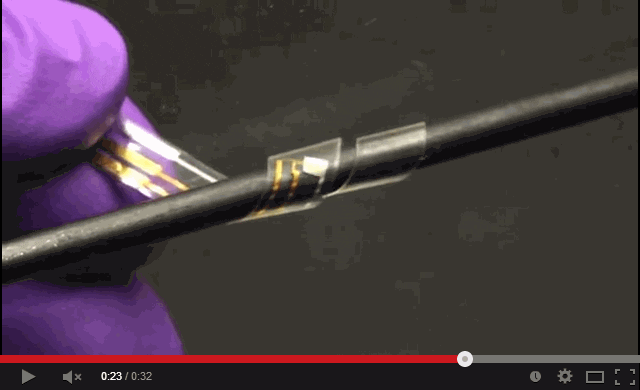
Electronic devices that become soft when implanted inside the body and can deploy to grip 3-D objects, such as large tissues, nerves and blood vessels
Researchers from The University of Texas at Dallas and the University of Tokyo have created electronic devices that become soft when implanted inside the body and can deploy to grip 3-D objects, such as large tissues, nerves and blood vessels.
These biologically adaptive, flexible transistors might one day help doctors learn more about what is happening inside the body, and stimulate the body for treatments.
The research, available online and in an upcoming print issue of Advanced Materials, is one of the first demonstrations of transistors that can change shape and maintain their electronic properties after they are implanted in the body, said Jonathan Reeder BS’12, a graduate student in materials science and engineering and lead author of the work.
“Scientists and physicians have been trying to put electronics in the body for a while now, but one of the problems is that the stiffness of common electronics is not compatible with biological tissue,” he said. “You need the device to be stiff at room temperature so the surgeon can implant the device, but soft and flexible enough to wrap around 3-D objects so the body can behave exactly as it would without the device. By putting electronics on shape-changing and softening polymers, we can do just that.”
Shape memory polymers developed by Dr. Walter Voit, assistant professor of materials science and engineering and mechanical engineering and an author of the paper, are key to enabling the technology.
The polymers respond to the body’s environment and become less rigid when they’re implanted. In addition to the polymers, the electronic devices are built with layers that include thin, flexible electronic foils first characterized by a group including Reeder in work published last year in Nature.
The Voit and Reeder team from the Advanced Polymer Research Lab in the Erik Jonsson School of Engineering and Computer Science fabricated the devices with an organic semiconductor but used adapted techniques normally applied to create silicon electronics that could reduce the cost of the devices.
“We used a new technique in our field to essentially laminate and cure the shape memory polymers on top of the transistors,” said Voit, who is also a member of the Texas Biomedical Device Center. “In our device design, we are getting closer to the size and stiffness of precision biologic structures, but have a long way to go to match nature’s amazing complexity, function and organization.”
The rigid devices become soft when heated. Outside the body, the device is primed for the position it will take inside the body.
During testing, researchers used heat to deploy the device around a cylinder as small as 2.25 millimeters in diameter, and implanted the device in rats. They found that after implantation, the device had morphed with the living tissue while maintaining excellent electronic properties.
“Flexible electronics today are deposited on plastic that stays the same shape and stiffness the whole time,” Reeder said. “Our research comes from a different angle and demonstrates that we can engineer a device to change shape in a more biologically compatible way.”
The next step of the research is to shrink the devices so they can wrap around smaller objects and add more sensory components, Reeder said.
The Latest on: Biologically adaptive flexible transistors
[google_news title=”” keyword=”Biologically adaptive flexible transistors” num_posts=”10″ blurb_length=”0″ show_thumb=”left”]
via Google News
The Latest on: Biologically adaptive flexible transistors
- Organic electrochemical transistors: Scientists solve chemical mystery at the interface of biology and technologyon April 30, 2024 at 11:22 am
Researchers who want to bridge the divide between biology and technology spend a lot of time thinking about translating between the two different "languages" of those realms.
- Organic Field-Effect Transistors: The Future of Flexible Electronicson April 18, 2024 at 7:44 am
Unlike conventional transistors that rely on inorganic semiconductors like silicon, OFETs leverage the unique properties of organic materials to enable novel applications in flexible ... can be used ...
- 5 Key Essentials Of Adaptive Leadershipon April 9, 2024 at 5:03 am
Marcus Aurelius wrote, "Obstacles do not block the path, they are the path." Adaptive leaders with a growth mindset do not just embrace this philosophy. They use it as fuel for their journey to ...
- Advancements in Flexible and Adaptive Electronics A Breakthrough Material for Wearables and Sensorson March 20, 2024 at 2:44 am
The development of this novel material with adaptive durability represents a significant advancement in the field of flexible electronics. By drawing inspiration from nature and leveraging ...
- Biological Scienceson October 3, 2023 at 3:24 pm
The Department of Biological Sciences treats the life sciences in all their breadth and diversity, including the study of molecules, cells, whole organisms, ecosystems, plants, animals and ...
- CPU Built From Discrete Transistorson September 29, 2023 at 8:21 pm
We all know, at least intellectually, that our computers are all built with lots of tiny transistors. But beyond that it’s a little hard to describe. They’re printed on a silicon wafer somehow ...
- FET: The Friendly Efficient Transistoron April 25, 2023 at 12:59 am
If you ever work with a circuit that controls a decent amount of current, you will often encounter a FET – a Field-Effect Transistor. Whether you want to control a couple of powerful LEDs ...
- Transistors explained – what they are and what they doon October 24, 2022 at 11:53 am
Unlike conventional transistors that rely on inorganic semiconductors like silicon, OFETs leverage the unique properties of organic materials to enable novel applications in flexible, printable, and ...
- The Sandwich Transistoron June 15, 2018 at 7:58 am
The sandwich transistor was William Shockley's brainchild. It's also called the junction transistor. While the rest of the lab was busy researching Bardeen and Brattain's point-contact transistor ...
- Point Contact Transistoron June 25, 2017 at 1:02 am
The first transistor was about half an inch high. That's mammoth by today's standards, when 7 million transistors can fit on a single computer chip. It was nevertheless an amazing piece of technology.
via Bing News









